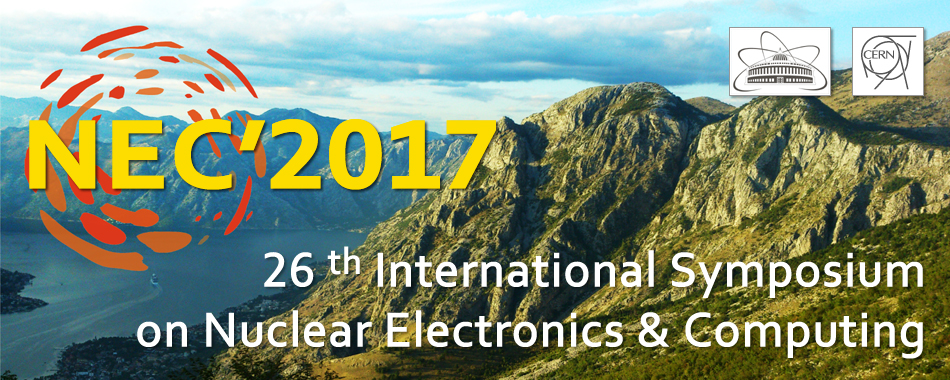Conveners
Detector & Nuclear Electronics
- Sergey Sidorchuk (FLNR JINR)
Detector & Nuclear Electronics
- Maxim Karetnikov (VNIIA)
Mr
Yury Tsyganov
(JINR)
26/09/2017, 14:30
Detector & Nuclear Electronics
Sectional
Two scenarios of modifying the DGFRS (the Dubna Gas Filled Recoil Separator) spectrometer of rare alpha decays are under consideration. Both of them imply use of integral 1M CAMAC analog-to-digital processor TekhInvest ADP-16 [1,2] as a basic unit in the spectrometer design. In scenario a) special unit (PKK-05) [3] will be used to measure horizontal position of the signal, without measuring...
Mr
Alexey Voinov
(FLNR JINR)
26/09/2017, 15:00
Detector & Nuclear Electronics
Sectional
The detection system of the Dubna gas-filled recoil separator (DGFRS) aimed at the studying of the SHE nuclei and their decay properties has been modernized during last few years. The new set of multistrips double-sided silicon detectors (DSSD) in focal plane of DGFRS is applied now instead of the old array of 12-strips position-sensitive Si detectors. The total amount of measuring...
Mr
Leo Schlattauer
(Palacky University Olomouc, Czech Republic, JINR Dubna)
26/09/2017, 15:15
Detector & Nuclear Electronics
Sectional
New particle position determination modules for Double side silicon strip detector were designed that allow to simplify existing multi-channel measurement system in search for the rare events of super heavy elements formation at DGFRS. The main principle is to search position correlated sequences of implanted SHE and followed alpha-particles/or SF events above predefined threshold Energy level...
Dr
Maxim Karetnikov
(VNIIA)
26/09/2017, 15:30
Detector & Nuclear Electronics
Sectional
At the T(d,n)He4 reaction each 14 MeV neutron is accompanied by a 3.5 MeV alpha- particle emitted in the opposite direction. A position- and time-sensitive alpha-detector measures time and coordinates of the associated alpha particle which allows determining time and direction (tags) of neutron escape. The tagged neutron technology is based on a time and spatial selection of events that...
Mr
Vladimir Drozdov
(FLNP JINR)
26/09/2017, 15:45
Detector & Nuclear Electronics
Sectional
The report describes the electronics and software of data acquisition systems for thermal neutron detectors [1], which are currently used on the spectrometers of the IBR-2 reactor at JINR. The experience gained during the operation of these systems has been summarized, the results of the performance analysis of the data acquisition systems developed in the FLNP for position-sensitive neutron...
Mr
Dmitrii Monakhov
(JINR)
26/09/2017, 16:30
Detector & Nuclear Electronics
Sectional
A few improvements have been made in order to enhance the resolution of the Q measurement system such as development of the additional NI FlexRIO digitizer module with two 18-Bit ADC AD7960 and TDC-GP22 for precision beam revolution frequency measurement. The new amplification system for picking up signals was developed using diode detection technique, analog filtering and real-time gain...
Dr
Lubomir Dimitrov
(INRNE - BAS)
26/09/2017, 16:45
Detector & Nuclear Electronics
Sectional
The higher energy and luminosity of future (HL) LHC imposed the development and testing of new type high-rate detectors as GEM (Gas Electron Multiplier). A monitoring system designed for measurement of the dose absorbed by the GEM detectors during the tests has been recently described [1]. The system uses a basic detector unit, called RADMON. There are in each unit two types of sensors:...
Mr
Dmitriy Ponkin
(LHEP JINR)
26/09/2017, 17:00
Triggering, Data Acquisition, Control Systems
Sectional
During the work on the creation of a new Electron String Ion Source (ESIS) for the NICA/MPD project several electronic modules were created.
Modules includes pulsed HV (+3 kV) potential barriers formation modules used to hold ions, HV (+3 kV) ion extraction module and several secondary modules.
Modules development process and test results are discribed.
Hristo Nazlev
(JINR)
26/09/2017, 17:15
Triggering, Data Acquisition, Control Systems
Sectional
The report describes requirements for the Booster injection system, its operation algorithm and realization details. The control system is based on National Instruments CompactRIO equipment and realizes injection devices control, synchronization and monitoring. The results of high voltage tests are presented.

